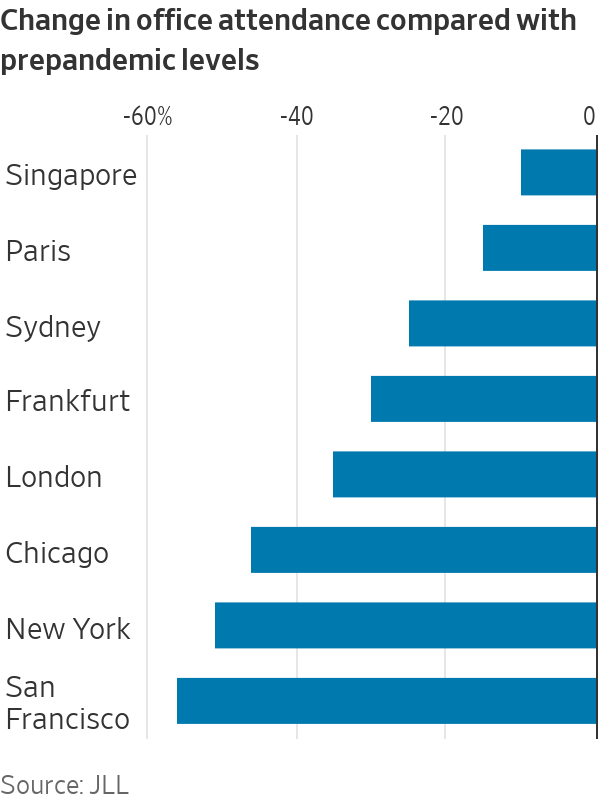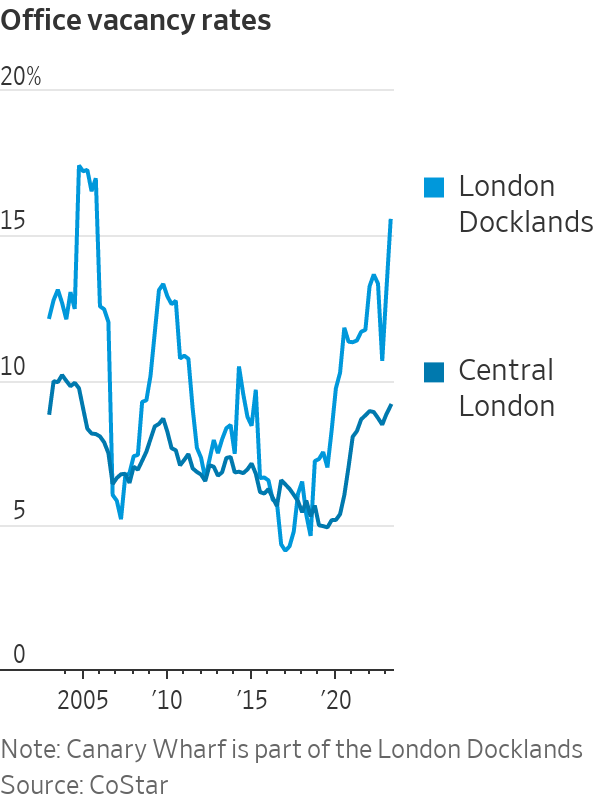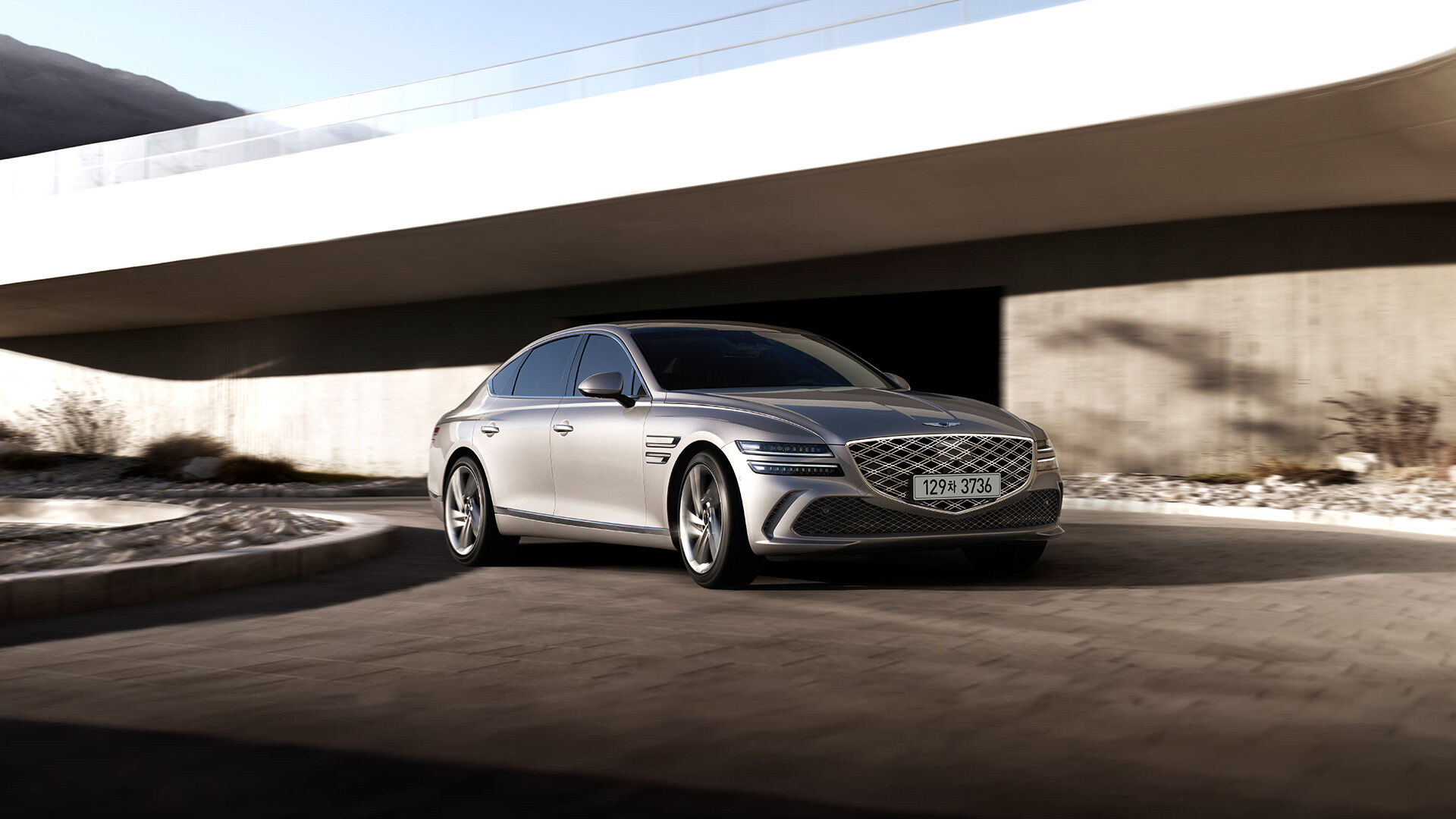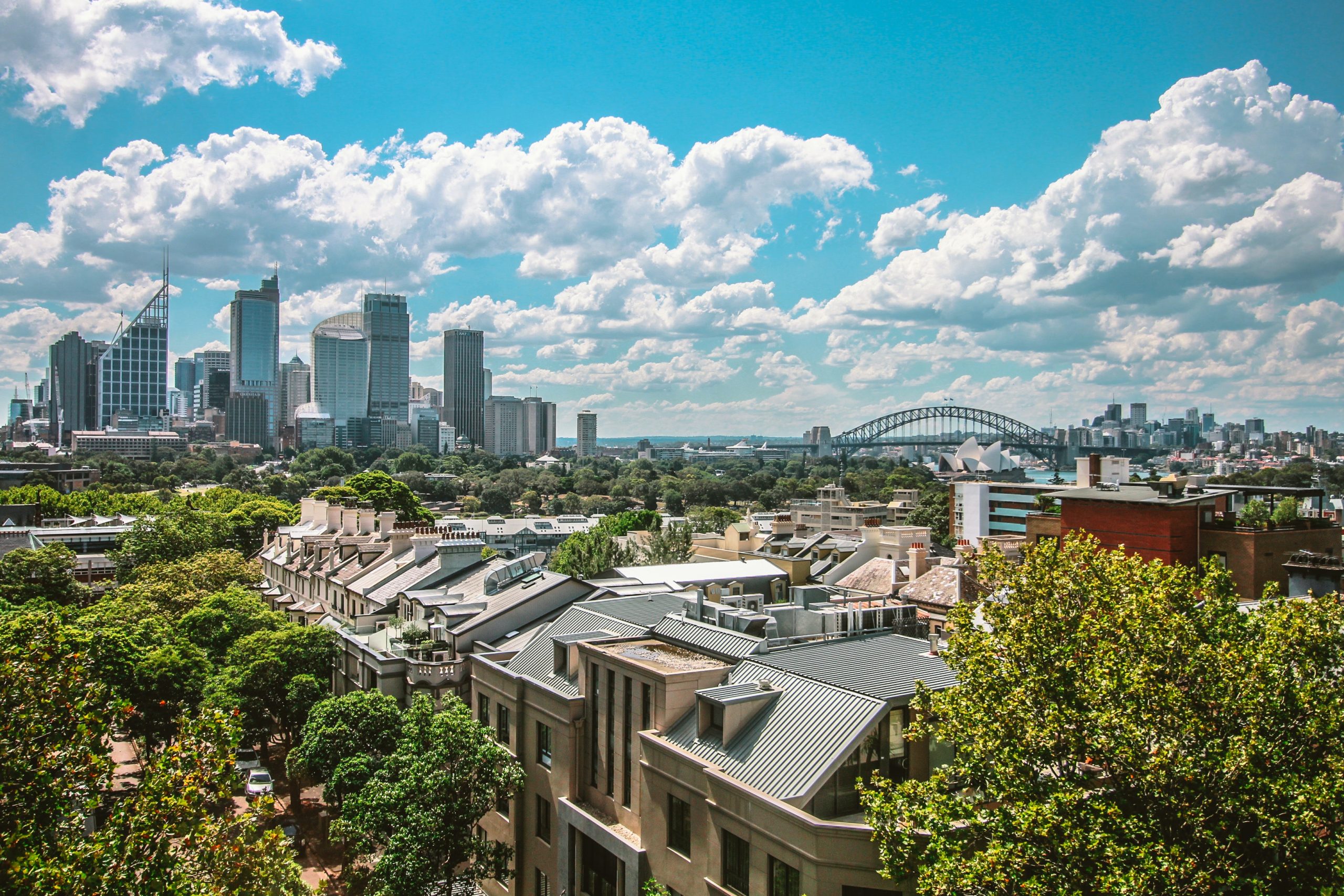London’s Canary Wharf Takes Brunt of Real-Estate Pain
Empty offices, remote working and corporate tenants fleeing to buzzier areas hit the 30-year-old business district
LONDON—Three decades ago, London remade a derelict shipping yard at Canary Wharf into a forest of glass-and-concrete skyscrapers in a bid to mimic U.S. financial hubs.
Now the 128-acre banking district east of central London is suffering a problem also plaguing U.S. cities: emptying office buildings.
Last month, HSBC Holdings, the U.K.’s largest financial firm, said it was leaving its 1.1-million-square-foot headquarters, known as the HSBC Tower, for a smaller building in central London. The move followed a decision by law firm Clifford Chance to relocate to central London and major office-space downsizings by Barclays and Société Générale, among others.

Already, Canary Wharf and its surrounding area have an availability rate of 17.1%, roughly the size of an empty Empire State Building, compared with 10.7% for central London, according to data provided by UBS.
Bonds for Canary Wharf Group—the company that owns most of the buildings in the area—are trading at a deep discount, with yields over 16%. Moody’s lowered its credit rating to junk last month.
The troubles at Canary Wharf show how the rapid rise of remote work has reverberated unevenly across global property markets. While the hollowing out of skyscrapers has become a familiar theme in U.S. cities since the pandemic, Europe’s office market has held up relatively well, as workers have been far more eager to return to the office.
But London has some problems that are familiar to American real estate.
The return-to-office rate for London stood at 65% in February, a figure that put it between New York City, which stood at 49%, and Paris, which was at 85%, according to JLL, a property-services company.
Canary Wharf has caught the brunt of the problems in London’s office market.
Work-from-home and the cost of upgrading old office space to meet environmental regulations “puts Canary Wharf at a disadvantage,” said Zachary Gauge, head of European real-estate research at UBS.
Canary Wharf was a byproduct of a changing London economy in the 1980s. Transformations in global shipping decimated the city’s sprawling blue-collar dockyards, the West India Docks. Margaret Thatcher’s government deregulated the financial industry in a move known as the “big bang,” and banks were hungry for towers that were larger than low-slung London’s standard fare.
While it wasn’t a great property investment—the original developer went bankrupt—skyscrapers sprouted through the 1990s and Canary Wharf became a rare slice of Manhattan in London.

Canary Wharf attracted tenants from London’s traditional financial district, known as the City of London, which lies several miles west. It became a global byword for urban renewal. Former New York Mayor Michael Bloomberg made it his go-to analogy when promoting plans for Hudson Yards in the late 2000s.
“Canary Wharf beat out the City in the 1990s and 2000s because it catered to American firms who wanted high-rise buildings for high-skilled labor,” said Anthony Breach, an analyst at the Centre for Cities, a think tank.
A generation later, its towers are far from new, while sleek modern skyscrapers have shot up in the buzzier streets of the City and other parts of central London.
“High rates of work from home means that employers need to offer some desirability and vibrancy to bring workers back,” said Marie Dormeuil, an analyst at Green Street, a commercial-real-estate advisory firm.
Top-end commercial-property rents in London’s more fashionable West End rose 8% a year over the past three years, buoyed by hedge funds and private-equity firms piling into Georgian townhouses, while rents in Canary Wharf have mostly stayed the same, according to Green Street. Average office-space rent in Canary Wharf is $69 a square foot, compared with $95 in the City and more than $165 in the West End, according to data from Knight Frank, a U.K. real-estate brokerage.
With most of the district held by Canary Wharf Group—a joint venture between Qatar’s wealth fund and private-equity giant Brookfield—or by the Qatari fund directly, the development has space for long-term planning. “The Canary Wharf Group is very good at making its own weather,” said Tony Travers, who directs the London School of Economics’ London centre.
Shobi Khan, Canary Wharf Group’s chief executive, has outlined a plan for a “Canary Wharf 3.0” that would thrive off of residential rents, entertainment offerings and biotech.
The group plans to construct a 750,000-square-foot life-sciences centre, which it says will be the largest commercial lab in Europe. Rents in the sector can bring in a 70% premium compared with office space, according to Savills, a British real-estate-services company.
As for the residential sector, 3,500 people inhabit the group’s 2,200 units there, compared with zero tenants three years ago. Two thousand more units are under construction.
A combination of high-end retailers, restaurants and music and arts festivals have brought in extra revenue. Foot traffic on evenings and weekends is up by 50% compared with pre pandemic levels, according to data from the city’s transport authority.
But a full makeover will be a difficult task to pull off. Higher interest rates and lower revenue mean that Qatar and Brookfield may need to put up more cash to cover the costs of refurbishment and construction.
Another risk: Fewer financiers and lawyers could mean little demand for the stores and amenities. “You could see a downward spiral as people start to leave,” said Breach, the think tank analyst.
The developers will likely need to lure in lots of people like Justin Walker, a tax accountant who works in JPMorgan Chase’s office there.
“I hated how sterile Canary Wharf looked when I first got here,” he said, “But, the place has grown on me, it’s more residential now, and a lot more vibrant.”
 Copyright 2020, Dow Jones & Company, Inc. All Rights Reserved Worldwide. LEARN MORE
Copyright 2020, Dow Jones & Company, Inc. All Rights Reserved Worldwide. LEARN MORE
Chris Dixon, a partner who led the charge, says he has a ‘very long-term horizon’
Americans now think they need at least $1.25 million for retirement, a 20% increase from a year ago, according to a survey by Northwestern Mutual
The G80 Sport makes its entrance, displaying dynamic design details and elevated automative capabilities.
Juma Al Majid LLC, the exclusive dealer for Genesis in the UAE, has launched the G80 – a cutting-edge luxury sedan. Merging tradition with innovation, this model embodies Genesis‘ relentless pursuit of superior design, state-of-the-art technology, and unmatched luxury.
The new G80 marks a significant milestone in introducing Korean automotive excellence to the UAE, highlighting the brand’s commitment to providing exceptional experiences.
Meticulously crafted, the redesigned G80 adheres to the ‘Athletic Elegance’ design philosophy synonymous with Genesis. This luxury vehicle features refined details and cutting-edge specifications, combining comfort and style to elevate every driving experience to new heights.
“The debut of the all-new G80 in the UAE market propels our vision to converge advanced technology and refined elegance”, stated Suliman Al Zaben, Director of Genesis, UAE. “This launch is a step forward for Genesis in the UAE market and strengthens our efforts to offer ultimate luxury, innovation, and unique design to our incisive customer base.”
With a new dual-mesh design, the G80’s exterior enhances the sophisticated appearance of the Two-Line Crest Grille, paired with iconic Two-Line headlamps featuring Micro Lens Array (MLA) technology. This highlights Genesis’ commitment to harmonizing advanced technology with elegant design. The five 20-inch double-spoke wheels exude a dynamic aesthetic, resembling sleek aircraft lines, complementing the car’s parabolic side profile. Rear diffusers conceal mufflers adorned with distinctive V-shaped chrome trim inspired by the Crest Grille, embodying an eco-conscious ethos in today’s technology-driven era.

The G80 reinforces Genesis’ design philosophy in its interiors, inspired by the uniquely Korean concept of the Beauty of White Space, integrated with state-of-the-art technology to create cosmetic brilliance for users. The 27-inch-wide OLED display seamlessly combines the cluster and AVN (Audio, Video, Navigation) screen in a horizontal layout, extending to the center fascia, showcasing its flair for innovative technology. The touch-based HVAC (Heating, Ventilation, and Air Conditioning) system offers ease of control, while the redesigned crystal-like Shift By Wire (SBW) ensures a comfortable grip, infusing a sense of luxurious convenience.
With its dual-layered Crest Grille and expanded air intakes, the G80 Sport package delivers a dynamic and sporty spirit. Exclusive interior options, such as a D-cut steering wheel and carbon accents, enhance its sporty allure. Equipped with Rear Wheel Steering (RWS) and Electronic Limited Slip Differential (E-LSD), the G80 Sport 3.5 twin turbo model is built for stable control during high-speed maneuvers.
Fitted with advanced safety and convenience features, this luxury sedan includes Remote Smart Parking Assist 2, Lane Following Assist 2, and a Fingerprint Authentication System. The three-zone HVAC system provides customized climate control for all passengers. With two powertrain options – a 2.5 turbo engine delivering 300 horsepower and 43.0 kgf·m of torque, and a 3.5 twin turbo engine producing 375 horsepower and 54.0 kgf·m of torque – superior driving dynamics ensure a silent and luxurious driving experience.

Chris Dixon, a partner who led the charge, says he has a ‘very long-term horizon’
Americans now think they need at least $1.25 million for retirement, a 20% increase from a year ago, according to a survey by Northwestern Mutual





















